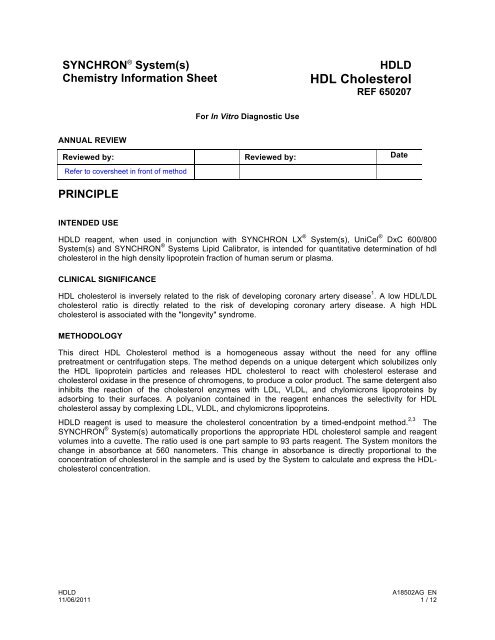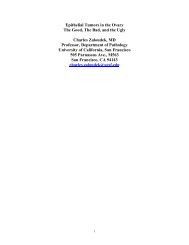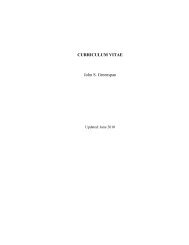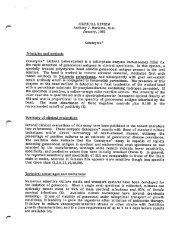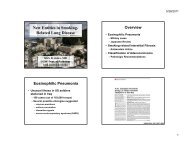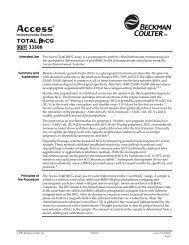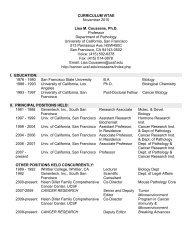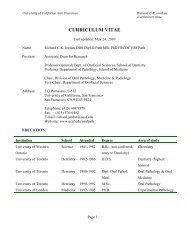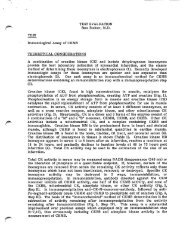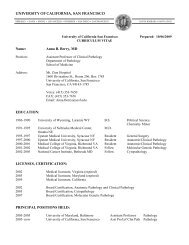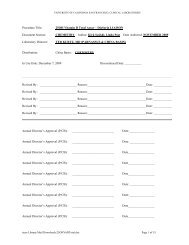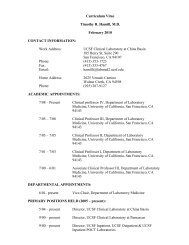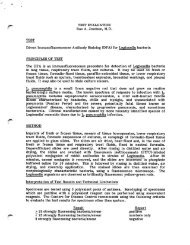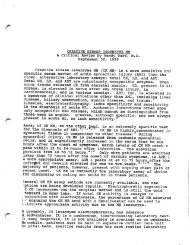HDL Cholesterol
HDL Cholesterol
HDL Cholesterol
You also want an ePaper? Increase the reach of your titles
YUMPU automatically turns print PDFs into web optimized ePapers that Google loves.
SYNCHRON ® System(s)<br />
Chemistry Information Sheet<br />
ANNUAL REVIEW<br />
For In Vitro Diagnostic Use<br />
<strong>HDL</strong>D<br />
<strong>HDL</strong> <strong>Cholesterol</strong><br />
REF 650207<br />
Reviewed by: Reviewed by: Date<br />
Refer to coversheet in front of method<br />
PRINCIPLE<br />
INTENDED USE<br />
<strong>HDL</strong>D reagent, when used in conjunction with SYNCHRON LX ® System(s), UniCel ® DxC 600/800<br />
System(s) and SYNCHRON ® Systems Lipid Calibrator, is intended for quantitative determination of hdl<br />
cholesterol in the high density lipoprotein fraction of human serum or plasma.<br />
CLINICAL SIGNIFICANCE<br />
<strong>HDL</strong> cholesterol is inversely related to the risk of developing coronary artery disease 1 . A low <strong>HDL</strong>/LDL<br />
cholesterol ratio is directly related to the risk of developing coronary artery disease. A high <strong>HDL</strong><br />
cholesterol is associated with the "longevity" syndrome.<br />
METHODOLOGY<br />
This direct <strong>HDL</strong> <strong>Cholesterol</strong> method is a homogeneous assay without the need for any offline<br />
pretreatment or centrifugation steps. The method depends on a unique detergent which solubilizes only<br />
the <strong>HDL</strong> lipoprotein particles and releases <strong>HDL</strong> cholesterol to react with cholesterol esterase and<br />
cholesterol oxidase in the presence of chromogens, to produce a color product. The same detergent also<br />
inhibits the reaction of the cholesterol enzymes with LDL, VLDL, and chylomicrons lipoproteins by<br />
adsorbing to their surfaces. A polyanion contained in the reagent enhances the selectivity for <strong>HDL</strong><br />
cholesterol assay by complexing LDL, VLDL, and chylomicrons lipoproteins.<br />
<strong>HDL</strong>D reagent is used to measure the cholesterol concentration by a timed-endpoint method. 2,3 The<br />
SYNCHRON ® System(s) automatically proportions the appropriate <strong>HDL</strong> cholesterol sample and reagent<br />
volumes into a cuvette. The ratio used is one part sample to 93 parts reagent. The System monitors the<br />
change in absorbance at 560 nanometers. This change in absorbance is directly proportional to the<br />
concentration of cholesterol in the sample and is used by the System to calculate and express the <strong>HDL</strong>cholesterol<br />
concentration.<br />
<strong>HDL</strong>D A18502AG EN<br />
11/06/2011 1 / 12
CHEMICAL REACTION SCHEME<br />
SPECIMEN<br />
TYPE OF SPECIMEN<br />
Biological fluid samples should be collected in the same manner routinely used for any laboratory test. 4<br />
Freshly drawn serum or plasma are the preferred specimens. Acceptable anticoagulants are listed in the<br />
PROCEDURAL NOTES section of this chemistry information sheet. Whole blood or urine are not<br />
recommended for use as a sample.<br />
SPECIMEN STORAGE AND STABILITY<br />
1. Tubes of blood are to be kept closed at all times and in a vertical position. It is recommended that the<br />
serum or plasma be physically separated from contact with cells within two hours from the time of<br />
collection. 5<br />
2. Separated serum or plasma should not remain at room temperature longer than 8 hours. If assays are<br />
not completed within 8 hours, serum or plasma should be stored at +2°C to +8°C. If assays are not<br />
completed within 48 hours, samples should be frozen at -15°C to -20°C. Frozen samples should be<br />
thawed only once. Analyte deterioration may occur in samples that are repeatedly frozen and thawed. 5<br />
ADDITIONAL SPECIMEN STORAGE AND STABILITY CONDITIONS AS DESIGNATED BY THIS LABORATORY:<br />
Refer to “Sample Integrity in Chemistry” write up in “Policies and Procedures” manual<br />
SAMPLE VOLUME<br />
The optimum volume, when using a 0.5 mL sample cup, is 0.3 mL of sample. For optimum primary<br />
sample tube volumes and minimum volumes, refer to the Primary Tube Sample Template for your<br />
system.<br />
CRITERIA FOR UNACCEPTABLE SPECIMENS<br />
Refer to the PROCEDURAL NOTES section of this chemistry information sheet for information on<br />
unacceptable specimens.<br />
<strong>HDL</strong>D A18502AG EN<br />
11/06/2011 2 / 12
CRITERIA FOR SAMPLE REJECTION AS DESIGNATED BY THIS LABORATORY:<br />
Refer to “Sample Integrity in Chemistry” write up in “Policies and Procedures” manual<br />
PATIENT PREPARATION<br />
SPECIAL INSTRUCTIONS FOR PATIENT PREPARATION AS DESIGNATED BY THIS LABORATORY:<br />
Refer to “Sample Integrity in Chemistry” write up in “Policies and Procedures” manual<br />
SPECIMEN HANDLING<br />
SPECIAL INSTRUCTIONS FOR SPECIMEN HANDLING AS DESIGNATED BY THIS LABORATORY:<br />
Refer to “Sample Integrity in Chemistry” write up in “Policies and Procedures” manual<br />
REAGENTS<br />
CONTENTS<br />
Each kit contains the following items:<br />
Two <strong>HDL</strong>D Reagent Cartridges (2 x 200 tests)<br />
VOLUMES PER TEST<br />
Sample Volume 3 µL<br />
Total Reagent Volume 280 µL<br />
Cartridge Volumes<br />
A 210 µL<br />
B 70 µL<br />
C – –<br />
REACTIVE INGREDIENTS<br />
REAGENT CONSTITUENTS<br />
<strong>Cholesterol</strong> esterase (bacterial) 1250 IU/L<br />
<strong>Cholesterol</strong> oxidase (bacterial) 1600 IU/L<br />
Peroxidase (horseradish) 5000 IU/L<br />
Polyanion 0.1%<br />
Detergent 1.0%<br />
Also non-reactive chemicals necessary for optimal system performance.<br />
<strong>HDL</strong>D A18502AG EN<br />
11/06/2011 3 / 12
MATERIALS NEEDED BUT NOT SUPPLIED WITH REAGENT KIT<br />
SYNCHRON ® Systems Lipid Calibrator<br />
At least two levels of control material<br />
Saline<br />
REAGENT PREPARATION<br />
No preparation is required.<br />
ACCEPTABLE REAGENT PERFORMANCE<br />
The acceptability of a reagent is determined by successful calibration and by ensuring that quality control<br />
results are within your facility's acceptance criteria.<br />
REAGENT STORAGE AND STABILITY<br />
<strong>HDL</strong> <strong>Cholesterol</strong> Reagent when stored unopened at +2°C to +8°C, will attain the shelf-life indicated on<br />
the cartridge label. Once opened, the reagent is stable for 60 days at +2°C to +8°C unless the expiration<br />
date is exceeded. DO NOT FREEZE.<br />
REAGENT STORAGE LOCATION:<br />
Chemistry section, room L568. Refer to reagent “map” on Chemistry refrigerator #6.<br />
CALIBRATION<br />
CALIBRATOR REQUIRED<br />
SYNCHRON ® Systems Lipid Calibrator<br />
CALIBRATOR PREPARATION<br />
No preparation is required.<br />
CALIBRATOR STORAGE AND STABILITY<br />
If unopened, the SYNCHRON ® Systems Lipid Calibrator may be stored at -15°C to -20°C until the<br />
expiration date printed on the calibrator bottle. Opened calibrators that are resealed and stored at +2°C to<br />
+8°C are stable for 60 days unless the expiration date is exceeded.<br />
<strong>HDL</strong>D A18502AG EN<br />
11/06/2011 4 / 12
CAUTION<br />
Because this product is of human origin, it should be handled as though<br />
capable of transmitting infectious diseases. Each serum or plasma donor unit<br />
used in the preparation of this material was tested by United States Food and<br />
Drug Administration (FDA) approved methods and found to be negative for<br />
antibodies to HIV and HCV and nonreactive for HbsAg. Because no test<br />
method can offer complete assurance that HIV, hepatitis B virus, and hepatitis<br />
C virus or other infectious agents are absent, this material should be handled<br />
as though capable of transmitting infectious diseases. This product may also<br />
contain other human source material for which there is no approved test. The<br />
FDA recommends such samples to be handled as specified in Centers for<br />
Disease Control's Biosafety Level 2 guidelines. 6<br />
CALIBRATOR STORAGE LOCATION:<br />
Refer to “DXC800 Calibration Quick Reference” chart in DXC800 procedure manual. Unopened Lipid<br />
Calibrator kept frozen (-15°C to -20°C) in Chemistry freezer #8.<br />
CALIBRATION INFORMATION<br />
1. The system must have valid calibration factors in memory before controls or patient samples can be<br />
run.<br />
2. Under typical operating conditions the <strong>HDL</strong>D assay must be calibrated every 30 days or with each new<br />
cartridge of reagent and also with certain parts replacements or maintenance procedures, as defined<br />
in the SYNCHRON LX Maintenance Manual and Instrument Log, or the UniCel DxC 600/800 System<br />
Instructions For Use (IFU) manual. This assay has within-lot calibration available. Refer to the<br />
SYNCHRON LX Operations Manual, or the UniCel DxC 600/800 Systems Instructions For Use (IFU)<br />
manual for information on this feature.<br />
3. For detailed calibration instructions, refer to the SYNCHRON LX Operations Manual, or the UniCel<br />
DxC 600/800 System Instructions For Use (IFU) manual.<br />
4. The system will automatically perform checks on the calibration and produce data at the end of<br />
calibration. In the event of a failed calibration, the data will be printed with error codes and the system<br />
will alert the operator of the failure. For information on error codes, refer to the SYNCHRON LX<br />
Diagnostics and Troubleshooting Manual, or the UniCel DxC 600/800 System Instructions For Use<br />
(IFU) manual.<br />
TRACEABILITY<br />
For Traceability information refer to the Calibrator instructions for use.<br />
QUALITY CONTROL<br />
At least two levels of control material should be analyzed daily. In addition, these controls should be run<br />
with each new calibration, with each new reagent cartridge, and after specific maintenance or<br />
troubleshooting procedures as detailed in the appropriate system manual. More frequent use of controls<br />
or the use of additional controls is left to the discretion of the user based on good laboratory practices or<br />
laboratory accreditation requirements and applicable laws.<br />
<strong>HDL</strong>D A18502AG EN<br />
11/06/2011 5 / 12
The following controls should be prepared and used in accordance with the package inserts. Discrepant<br />
quality control results should be evaluated by your facility.<br />
TABLE 1 QUALITY CONTROL MATERIAL<br />
CONTROL NAME SAMPLE TYPE STORAGE<br />
Monitrol levels 1 and 2 vials in use kept refrigerated after thawing. Unopened Monitrol kept frozen until just<br />
before use. Refer to “DXC 800 Control Analysis” in DXC 800 procedure manual for other control material used<br />
and storage. Control preparations and acceptance of QC results are in “Policies and Procedures” manual<br />
TESTING PROCEDURE(S)<br />
1. If necessary, load the reagent onto the system.<br />
2. After reagent load is completed, calibration may be required.<br />
3. Program samples and controls for analysis.<br />
4. After loading samples and controls onto the system, follow the protocols for system operations.<br />
For detailed testing procedures, refer to the SYNCHRON LX Operations Manual, or the UniCel DxC<br />
600/800 System Instructions For Use (IFU) manual.<br />
CALCULATIONS<br />
The SYNCHRON ® System(s) performs all calculations internally to produce the final reported result. The<br />
system will calculate the final result for sample dilutions made by the operator when the dilution factor is<br />
entered into the system during sample programming.<br />
REPORTING RESULTS<br />
Equivalency between the SYNCHRON LX and UniCel DxC 600/800 Systems has been established.<br />
Chemistry results between these systems are in agreement and data from representative systems may<br />
be shown.<br />
REFERENCE INTERVALS<br />
Each laboratory should establish its own reference intervals based upon its patient population. The<br />
reference interval listed below was taken from a study performed on SYNCHRON Systems.<br />
TABLE 2 REFERENCE INTERVALS 7,8<br />
INTERVALS CARDIOVASCULAR<br />
RISK<br />
CONVENTIONAL UNITS S.I. UNITS<br />
SYNCHRON Low ≥ 60 mg/dL ≥ 1.55 mmol/L<br />
High < 40 mg/dL < 1.03 mmol/L<br />
INTERVALS CARDIOVASCULAR<br />
RISK<br />
CONVENTIONAL UNITS S.I. UNITS<br />
Laboratory Acceptable > 39 mg/dL n/a<br />
Higher risk < 40 mg/dL<br />
Lower risk > 59 mg/dL<br />
<strong>HDL</strong>D A18502AG EN<br />
11/06/2011 6 / 12
Refer to References (9,10,11) for guidelines on establishing laboratory-specific reference intervals.<br />
ADDITIONAL REPORTING INFORMATION AS DESIGNATED BY THIS LABORATORY:<br />
Refer to “DXC800 Linearity and Reportable Range” chart in Technical notes section of DXC800 Procedure<br />
manual<br />
PROCEDURAL NOTES<br />
ANTICOAGULANT TEST RESULTS<br />
The following anticoagulants were assessed by Deming regression analysis with a minimum of 50 paired<br />
serum and plasma samples. Values of serum (X) ranging from 26 mg/dL to 127 mg/dL were compared<br />
with the values for plasma (Y) yield the following results.<br />
TABLE 3 ANTICOAGULANT TEST RESULTS<br />
ANTICOAGULANT LEVEL OF ANTICOAGULANT TESTED DEMING REGRESSION ANALYSIS<br />
Lithium Heparin 14 Units/mL Y = 1.012X + 0.7; r = 0.998<br />
Sodium Heparin 14 Units/mL Y = 1.030X - 0.3; r = 0.997<br />
LIMITATIONS<br />
Samples or control materials which contain acetic acid, detergents, or surfactants may inhibit the<br />
enzymes in the reagent and should not be used.<br />
INTERFERENCES<br />
1. The following substances were tested for interference with this methodology:<br />
TABLE 4 INTERFERENCES<br />
SUBSTANCE SOURCE LEVEL TESTED OBSERVED EFFECT<br />
Hemoglobin RBC hemolysate 500 mg/dL NSI a<br />
Bilirubin Porcine 30 mg/dL NSI<br />
Lipemia Human Triglyceride ≤<br />
1700<br />
NSI<br />
Ascorbic Acid NA b 50 mg/dL NSI<br />
Immunoglobulin IgG Human 3000 mg/dL NSI<br />
2. Extremely lipemic samples with triglycerides greater than 1700 mg/dL may give falsely low results.<br />
3. Inaccurate results (usually negative interference) may be produced in patients with elevated serum<br />
immunoglobulin levels. 12<br />
4. Falsely low results may be obtained in patients with Type III hyperlipidemia. 13<br />
5. Refer to References (14,15,16) for other interferences caused by drugs, disease and preanalytical<br />
variables.<br />
<strong>HDL</strong>D A18502AG EN<br />
11/06/2011 7 / 12
PERFORMANCE CHARACTERISTICS<br />
Analytic Range<br />
The SYNCHRON ® System(s) method for the determination of this analyte provides the following<br />
analytical ranges:<br />
TABLE 5 ANALYTICAL RANGE<br />
SAMPLE TYPE CONVENTIONAL UNITS S.I. UNITS<br />
Serum or Plasma 5 – 135 mg/dL 0.13 – 3.50 mmol/L<br />
Samples with concentrations exceeding the high end of the analytical range should be diluted with saline<br />
and reanalyzed.<br />
REPORTABLE RANGE (as determined on site):<br />
TABLE 6 REPORTABLE RANGE<br />
SAMPLE TYPE CONVENTIONAL UNITS S.I. UNITS<br />
Serum or Plasma 5 – 135 mg/dL n/a<br />
SENSITIVITY<br />
Sensitivity is defined as the lowest measurable concentration which can be distinguished from zero with<br />
95% confidence. Sensitivity for <strong>HDL</strong>D determination is 5 mg/dL (0.13 mmol/L).<br />
EQUIVALENCY<br />
Equivalency was assessed by Deming regression analysis of patient samples to accepted clinical<br />
methods.<br />
Serum or plasma (in the range of 5 to 83 mg/dL):<br />
Y (SYNCHRON LX Systems) = 0.973X + 0.5<br />
N = 66<br />
MEAN (SYNCHRON LX <strong>HDL</strong>D) = 40.3<br />
MEAN (SYNCHRON LX <strong>HDL</strong>C) = 41.0<br />
CORRELATION COEFFICIENT (r) = 0.972<br />
Serum or plasma (in the range of 7 to 130 mg/dL):<br />
Y (SYNCHRON LX Systems) = 0.893X + 6.7<br />
N = 80<br />
MEAN (SYNCHRON LX <strong>HDL</strong>D) = 52.4<br />
MEAN (SYNCHRON LX <strong>HDL</strong>D UDR Method) = 51.2<br />
CORRELATION COEFFICIENT (r) = 0.999<br />
Refer to References (17) for guidelines on performing equivalency testing.<br />
<strong>HDL</strong>D A18502AG EN<br />
11/06/2011 8 / 12
PRECISION<br />
A properly operating SYNCHRON ® System(s) should exhibit precision values less than or equal to the<br />
following:<br />
TABLE 7 PRECISION VALUES<br />
TYPE OF<br />
PRECISION<br />
SAMPLE TYPE 1 SD CHANGEOVER VALUE c mg/dL mmol/L mg/dL mmol/L<br />
% CV<br />
Within-run Serum/Plasma 3.0 0.07 100.0 2.3 3.0<br />
Total Serum/Plasma 4.5 0.11 100.0 2.3 4.5<br />
Comparative performance data for a SYNCHRON LX ® System evaluated using the NCCLS Proposed<br />
Guideline EP5-T2 appears in the table below. 18 Each laboratory should characterize their own instrument<br />
performance for comparison purposes.<br />
TABLE 8 NCCLS EP5-T2 PRECISION ESTIMATE METHOD<br />
TYPE OF<br />
IMPRECISION<br />
SAMPLE TYPE No.<br />
Systems<br />
No. Data<br />
Points d<br />
Test Mean<br />
Value<br />
(mg/dL)<br />
EP5-T2 Calculated<br />
Point Estimates<br />
SD %CV<br />
Within-run Serum Control 1 1 80 24.5 0.5 2.0<br />
Serum Control 2 1 80 56.0 1.0 1.8<br />
Serum Control 3 1 80 122.8 2.1 1.7<br />
Total Serum Control 1 1 80 24.5 0.8 3.4<br />
Serum Control 2 1 80 56.0 1.2 2.1<br />
Serum Control 3 1 80 122.8 2.8 2.2<br />
NOTICE<br />
These degrees of precision and equivalency were obtained in typical testing procedures on a<br />
SYNCHRON LX ® System and are not intended to represent the performance specifications for<br />
this reagent.<br />
ADDITIONAL INFORMATION<br />
For more detailed information on SYNCHRON LX Systems or UniCel DxC Systems, refer to the<br />
appropriate system manual.<br />
SHIPPING DAMAGE<br />
If damaged product is received, notify your Beckman Coulter Clinical Support Center.<br />
<strong>HDL</strong>D A18502AG EN<br />
11/06/2011 9 / 12
REFERENCES<br />
1. National <strong>Cholesterol</strong> Education Program (NCEP) Executive Summary of the Third Report, Expert<br />
Panel on "Detection, Evaluation, and Treatment of High Blood <strong>Cholesterol</strong> in Adults (Adult<br />
Treatment Panel III)", JAMA, 285:2486 (2001).<br />
2. Allain, C. C., et al., Clin. Chem., 20:470 (1974).<br />
3. Roeschlau, P., Bernt, E., Gruber, W., Z. Klin. Chem. Klin. Biochem., 12:226 (1974).<br />
4. Tietz, N. W., "Specimen Collection and Processing; Sources of Biological Variation", Textbook of<br />
Clinical Chemistry, 2nd Edition, W. B. Saunders, Philadelphia, PA (1994).<br />
5. National Committee for Clinical Laboratory Standards, Procedures for the Handling and<br />
Processing of Blood Specimens, Approved Guideline, NCCLS publication H18-A, Villanova, PA<br />
(1990).<br />
6. CDC-NIH manual, Biosafety in Microbiological and Biomedical Laboratories, U.S. Government<br />
Printing Office, Washington, D.C. (1984).<br />
7. NIH Publication No. 01 3305, ATP III Guidelines At-A-Glance, Quick Desk Reference, May<br />
(2001).<br />
8. NIH Publication No. 01 3670, Third Report of National <strong>Cholesterol</strong> Education Program (NCEP)<br />
Expert Panel on Detection, Evaluation and Treatment of High <strong>Cholesterol</strong> in Adults (Adult<br />
Treatment Panel III), May (2001).<br />
9. National Committee for Clinical Laboratory Standards, How to Define, Determine, and Utilize<br />
Reference Intervals in the Clinical Laboratory, Approved Guideline, NCCLS publication C28-A,<br />
Villanova, PA (1995).<br />
10. Tietz, N. W., ed., Fundamentals of Clinical Chemistry, 3rd Edition, W. B. Saunders, Philadelphia,<br />
PA (1987).<br />
11. Henry, J. B., Clinical Diagnosis and Management by Laboratory Methods, 18th Edition, W. B.<br />
Saunders Company, Philadelphia, PA (1991).<br />
12. Supplement 373, Clinical Chemistry, Vol. 46, No. 6 (2000).<br />
13. Technical Briefs, Clinical Chemistry, Vol. 46, No. 4 (2000).<br />
14. Young, D. S., Effects of Drugs on Clinical Laboratory Tests, 4th Edition, AACC Press,<br />
Washington, D. C. (1995).<br />
15. Friedman, R. B., Young, D. S.,Effects of Disease on Clinical Laboratory Tests, 3rd Edition, AACC<br />
Press, Washington, D.C. (1997).<br />
16. Young, D. S., Effects of Preanalytical Variables on Clinical Laboratory Tests, 2nd Edition, AACC<br />
Press, Washington, D. C. (1997).<br />
17. National Committee for Clinical Laboratory Standards, Method Comparison and Bias Estimation<br />
Using Patient Samples, Approved Guideline, NCCLS publication EP9-A, Villanova, PA (1995).<br />
<strong>HDL</strong>D A18502AG EN<br />
11/06/2011 10 / 12
18. National Committee for Clinical Laboratory Standards, Precision Performance of Clinical<br />
Chemistry Devices, Tentative Guideline, 2nd Edition, NCCLS publication EP5-T2, Villanova, PA<br />
(1992).<br />
Beckman Coulter, Inc., 250 South Kraemer Blvd., Brea, CA 92821<br />
<strong>HDL</strong>D A18502AG EN<br />
11/06/2011 11 / 12
ENDNOTES<br />
a NSI = No Significant Interference (within ±6.0 mg/dL or 6%).<br />
b NA = Not applicable.<br />
c When the mean of the test precision data is less than or equal to the changeover value, compare the<br />
test SD to the SD guideline given above to determine the acceptability of the precision testing. When<br />
the mean of the test precision data is greater than the changeover value, compare the test % CV to<br />
the guideline given above to determine acceptability. Changeover value = (SD guideline/CV<br />
guideline) x 100.<br />
d The point estimate is based on the pooled data from one system, run for twenty days, two runs per<br />
day, two observations per run on an instrument operated and maintained according to the<br />
manufacturer's instructions.<br />
<strong>HDL</strong>D A18502AG EN<br />
11/06/2011 12 / 12


